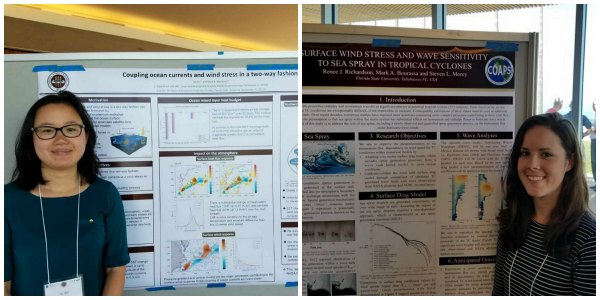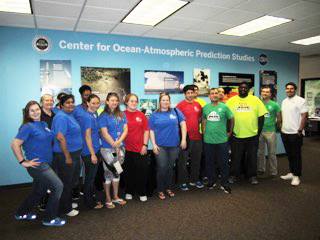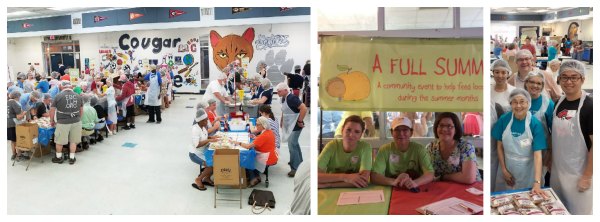COAPS welcomes back Director Eric Chassignet from sabbatical in Toulouse, France
|
|
|
Toulouse, France is home to several of the world's leading oceanographic institutions including the Université Paul Sabatier, Mercator Ocean, SHOM, CNES, CLS, CERFACS, and others.
|
COAPS is pleased to welcome back our center's director, Dr. Eric Chassignet, who returned from Toulouse, France last month after a two-semester sabbatical. Why Toulouse? First, because the Université Paul Sabatier (host to the Laboratoire d'Aérologie (LA) and the Laboratoire d'Etudes en Géophysique et Océanographie Spatiales (LEGOS), Mercator Ocean, the Service Hydrographique et Océanographique de la Marine (SHOM), Collecte Localisation Satellites (CLS), and the Centre National d'Etudes Spatiales (CNES) are all located there, making it a very unique environment for research collaborations that could enhance our ability to perform accurate global ocean forecasts.
 "I am extremely grateful to my hosts, the Université Paul Sabatier and the SHOM, for their warm welcome and the opportunity for a highly productive sabbatical, said Chassignet. My time there allowed me to reinforce existing collaborations and to define new ones."
"I am extremely grateful to my hosts, the Université Paul Sabatier and the SHOM, for their warm welcome and the opportunity for a highly productive sabbatical, said Chassignet. My time there allowed me to reinforce existing collaborations and to define new ones."
Since 2000, Dr. Chassignet has worked closely with the US Navy in putting together the next generation high resolution global ocean forecasting system based on the HYbrid Coordinate Ocean Model (HYCOM). HYCOM and Mercator Ocean are the only two global ocean forecasting systems in the world that offer predictive capabilities on horizontal scales of less than 10 km. Mercator Ocean is a non-profit company leading a European-wide effort to provide ocean-related products and is officially appointed by the European Commission to implement the European ocean-monitoring " Copernicus Marine Environment Monitoring Service" as part of the European Earth observation programme. COAPS is also one of only three groups worldwide doing the kind of high resolution modeling that is suitable to evaluate the French-US CNES-NASA's upcoming Surface Water & Ocean Topography (SWOT) mission.
"Being able to work closely with our European counterparts to compare the forecasting systems and improve their performance was a great experience," Chassignet said. But it is very good to be home and back at COAPS."
|
New NOAA/CPO grant to fund surface wind indices project
COAPS recently received a grant from NOAA's Climate Program Office to fund a project entitled 20th Century Atlantic surface wind indices. The project, proposed by PI Mark Bourassa and co-PI Shawn Smith, will improve ship winds in the long-term marine climate record and use the wind directions and speeds to develop climate indices related large scale circulation and select smaller scale process that impact weather on land in the continental U.S. Specifically, wind-related indices will be developed to identify and quantify variations in atmospheric circulation patterns over the oceans, with the goals of linking these to changes in precipitation over terrestrial regions, storminess, and coastal upwelling.
|
NASA grant to JPL and COAPS will integrate the DOMS service into the OceanWorks platform
OceanWorks is a webservice platform for users and applications to access, manipulate, and analyze oceanographic measurements. By hiding all the complexities of data management and cloud computing architecture, the OceanWorks provides a virtual environment for users and applications to conduct science. A grant recently awarded jointly to JPL and FSU will support the OceanWorks initiative. The FSU team, led by FSU PI
Shawn Smith and co-PI
Mark Bourassa, will be contributing its expertise to support the integration of the prototype
Distributed Oceanographic data Match-up Service (DOMS) into the OceanWorks platform.
|
|
Current and former COAPS-ians meet up at International Ocean Vector Winds Science Team (IOVWST) Meeting
|
|
Current and former COAPS-ians attended the annual International Ocean Vector Winds Science Team (IOVWST) meeting held in San Diego from May 2-4, 2017. Pictured (from left to right): Rachel Weihs (SIO), Yangxing Zheng, Lisan Yu (WHOI), Steve Morey, Mark Bourassa, Aaron Paget (UCONN), Heather Holbach, Renee Richardson, Qi Shi and David Moroni (JPL). For more on this and previous IOVWST meetings go to
https://mdc.coaps.fsu.edu/scatterometry/meeting/past.php
|
|
Catching up with COAPS Alum Rochelle Worsnop
COAPS and FSU alum, Rochelle Worsnop, is currently preparing to defend her doctoral thesis at the University of Colorado-Boulder (CU) this fall. Rochelle worked as an undergraduate research assistant at COAPS from 2009-2012 with Melissa Griffin, Shawn Smith, Mark Bourassa, Lydia Stefanova, and Philip Sura. Her research explored the multi-decadal variations of durations of extreme temperatures in the southeastern United States. She also assisted in fulfilling public data requests submitted to the Florida Climate Center. Her research at COAPS helped her receive the National Science Foundation Graduate Research Fellowship in 2012.
 |
|
 |
Since her time at FSU COAPS (2009-2012), alum Rochelle Worshop has been busy adding to her body of work wind power ramp forecasts and cat-5 hurricane simulations.
|
After earning her Bachelor's in meteorology, Rochelle moved to Boulder, Colorado to explore the Rocky Mountains and to pursue a Ph.D. in Atmospheric and Oceanic Sciences with her research advisor, Julie Lundquist. Her research at CU has focused on the impacts of hurricane wind conditions on offshore wind turbines and has provided guidance for their design. The work included large-eddy simulations of an idealized category-5 hurricane to capture a "worst-case" scenario for potential offshore wind turbines. A PBS Newshour article about her most recent paper on this topic highlights how this research could be used to better design turbines deployed in hurricane-prone regions. Rochelle is working on two other projects for her thesis. One project is a collaboration with the National Oceanic and Atmospheric Administration (NOAA) in Boulder, where she has been a part-time research intern for the past year under the federal Pathways Program. At NOAA, she is working to improve wind power ramp forecasts in the High-Resolution Rapid Refresh (HRRR) model via statistical post-processing and adding uncertainty estimates to create probabilistic ramp forecasts. Her final project for her thesis involves running simulations with the Wind Farm Parameterization (WFP) in the Weather Research & Forecasting (WRF) model to improve forecasts of wind farm power production and testing the effects of a new physics scheme developed by scientists at the National Center for Atmospheric Research.
Rochelle has also participated in three exciting field campaigns to collect observations with wind profiling lidars, radiometers, and radiosondes in Iowa (CWEX13), Colorado (XPIA), and the Columbia River Gorge (WFIP2). After graduate school, Rochelle hopes to continue working with her NOAA collaborators on topics related to wind energy and numerical weather prediction.
Recent Publications:
- Worsnop, R.P., Bryan, G.H., Lundquist, J.K. et al. (2017) Using large-eddy simulations to define spectral and coherence characteristics of the hurricane boundary layer for wind-energy applications Boundary-Layer Meteorol. https://doi.org/10.1007/s10546-017-0266-x
-
Worsnop, R. P., J. K. Lundquist, G. H. Bryan, R. Damiani, and W. Musial (2017),
Gusts and shear within hurricane eyewalls can exceed offshore wind turbine design standards,
Geophys. Res. Lett., 44, 6413-6420, doi:
10.1002/2017GL073537.
- Curriculum vitae (CV)
|
Adam Stallard successfully defended his Master's thesis, entitled "Comparing SAMOS Document Search Performance Between Apache Solr and Neo4j." Stallard's advisor has been Dr. Peixiang Zhao in the FSU Department of Computer Science.

COAPS students Qi Shi and Renee Richardson (L-R above) showcased their research at this year's International Vector Winds Science Team (IVWST) meeting's poster session in San Diego, CA.
|
OASIS Campers Become "Weather Wise" Girls Who Code!
Visitors from
the Oasis Center's "Girls Can Do Anything" summer camp stopped by COAPS on July 27 -- where they were treated to fun educational activities designed to make them "weather wise" girls who code! The campers learned about thunder and lightning, hurricanes, and weather safety. They also learned about sea level rise. And a special activity designed to help them understand what's involved in pseudocoding had them navigating COAPS' Lego Robot through an obstacle course like coding pros. Watch the video below to see some highlights from that day.

STEM Teachers Tour COAPS
Pictured on right: In June, COAPS was also pleased to welcome teachers from the
Tallahassee School of Math and Science (TSMS), formerly STARS, for a visit and tour of our Center. TSMS is an elementary and middle school (K through 8) with a special emphasis on Science, Technology, Engineering, Mathematics
(STEM), and Reading in the light of research based, proven and innovative instructional methods in a stimulating environment.
COAPS Make it "A FULL SUMMER"
On June 3, COAPS-ians Patty Boutelle, Xu Chen, Susan Greenwalt, and Tracy Ippolito spent their Saturday volunteering at A FULL SUMMER 2017, an annual food packaging event that brings together volunteers prepared to package meals for the hungry and food insecure in Leon County area. This year's event set a record with 61,560 meals prepared by 250+ volunteers in under two hours. Others at COAPS contributed to the Second Harvest Food Bank collection, and the donated food was presented to the food bank at the event.

Mentorship Breakfast Inspires Future Leaders
On May 20th, Danielle Groenen (PhD Student, Meteorology) participated in the S.T.E.A.M. & Entrepreneurship Mentor Breakfast at the 7th Annual L3 Leadership Conference at Florida A&M University. L3 stands for Ladies Learning to Lead, and L3's mission is to empower young ladies to become leaders by building confidence, character, and leadership skills to prepare them for college, careers, and life. The breakfast was geared toward Tallahassee middle school and high school girls. Groenen participated in a panel discussion and shared experience and advice about pursuing a career in science.
|
|
Recent Publications
COAPS authors are in bold.
|
Buijsman, M. C.; Arbic, B. K.; Richman, J. G.; Shriver, J. F.; Wallcraft, A. J.; Zamudio, L. (2017), Semidiurnal internal tide incoherence in the equatorial Pacific, Journal of Geophysical Research - Oceans, doi:10.1002/2016JC012590. (accepted).
Carstens, J. (2017), North Atlantic and Northeast Pacific Tropical Cyclone Intensity Comparison Using Integrated Kinetic Energy, Florida State University, Tallahassee, FL, USA (accepted).
Chassignet, E.P. and Xu, X.,
(2017),
Impact of horizontal resolution (1/12° to 1/50°) on Gulf Stream separation, penetration, and variability.
J. Phys. Oceanogr.,
Early Online Release,
https://doi.org/10.1175/JPO-D-17-0031.1
Cintra, R; Velho, HD; Cocke, S (2016), Tracking the model: data assimilation by artificial neural network, 2016 International Joint Conference on Neural Networks (IJCNN), IEEE; IEEE Computat Intelligence Soc; Int Nueral Network Soc; Evolutionary Programming Soc; IET; IEEE BigData; Gulf Univ Sci & Technol, Vancouver, BC, Canada. 403-410, doi:10.1109/IJCNN.2016.7727227.
De Souza-Machado, S; Tangborn, A;
Sura, P; Hepplewhite, C; Strow, LL (2017),
Non-Gaussian Analysis of Observations from the Atmospheric Infrared Sounder Compared with ERA and MERRA Reanalyses,
Journal of Applied Meteorology and Climatology, 56(5), 1463-1481, doi:10.1175/JAMC-D-16-0278.1.
Freeman, E; Woodruff, SD; Worley, SJ; Lubker, SJ; Kent, EC; Angel, WE; Berry, DI; Brohan, P; Eastman, R; Gates, L; Gloeden, W; Ji, ZH; Lawrimore, J; Rayner, NA; Rosenhagen, G;
Smith, SR, 2017:
ICOADS Release 3.0: a major update to the historical marine climate record. doi:10.1002/joc.4775.
Holbach, H. M.; Bourassa, M. A., 2017:
Platform and Across-Swath Comparison of Vorticity Spectra From QuikSCAT, ASCAT-A, OSCAT, and ASCAT-B Scatterometers.
IEEE Journal of Selected Topics in Applied Earth Observations and Remote Sensing, doi:10.1109/JSTARS.2016.2642583.
Savage, AC; Arbic, BK; Richman, JG; Shriver, JF; Alford, MH; Buijsman, MC; Farrar, JT; Sharma, H; Voet, G;
Wallcraft, AJ; Zamudio, L (2017),
Frequency content of sea surface height variability from internal gravity waves to mesoscale eddies,
Journal of Geophysical Research - Oceans, 122(3), 2519-2538, doi:10.1002/2016JC012331.
Selman, C. and
V. Misra, 2017:
The impact of an extreme case of irrigation on the southeastern United States climate.
Climate Dynamics, doi:10.1007/s00382-016-3144-1 .
Smith, S. R.; Berry, D. I. (2017),
Expanding a 300-year record of marine climate,
Eos, 98 doi:10.1029/2017EO068241.
Yarboro, J. (2017), Wildfire Modeling: Developing a Computer Simulation of a Burning Front using the Reaction-diffusion Equation, Florida State University, Tallahassee, FL, USA (accepted).
|
|